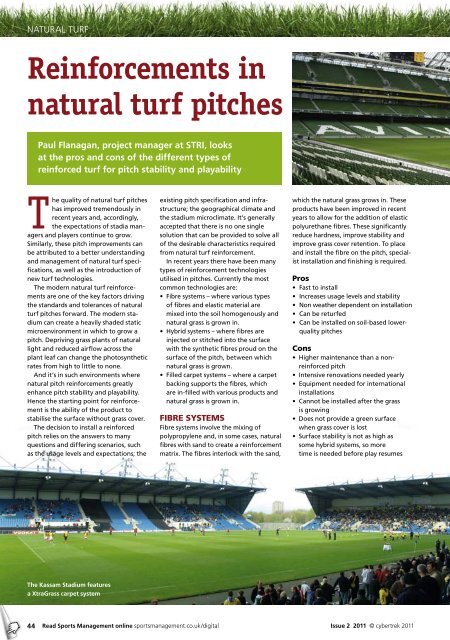Sports Management Q2 2011 - UUM
Sports Management Q2 2011 - UUM
Sports Management Q2 2011 - UUM
Create successful ePaper yourself
Turn your PDF publications into a flip-book with our unique Google optimized e-Paper software.
NATURAL TURF<br />
Reinforcements in<br />
natural turf pitches<br />
Paul Flanagan, project manager at STRI, looks<br />
at the pros and cons of the different types of<br />
reinforced turf for pitch stability and playability<br />
T<br />
he quality of natural turf pitches<br />
has improved tremendously in<br />
recent years and, accordingly,<br />
the expectations of stadia managers<br />
and players continue to grow.<br />
Similarly, these pitch improvements can<br />
be attributed to a better understanding<br />
and management of natural turf specifications,<br />
as well as the introduction of<br />
new turf technologies.<br />
The modern natural turf reinforcements<br />
are one of the key factors driving<br />
the standards and tolerances of natural<br />
turf pitches forward. The modern stadium<br />
can create a heavily shaded static<br />
microenvironment in which to grow a<br />
pitch. Depriving grass plants of natural<br />
light and reduced airflow across the<br />
plant leaf can change the photosynthetic<br />
rates from high to little to none.<br />
And it’s in such environments where<br />
natural pitch reinforcements greatly<br />
enhance pitch stability and playability.<br />
Hence the starting point for reinforcement<br />
is the ability of the product to<br />
stabilise the surface without grass cover.<br />
The decision to install a reinforced<br />
pitch relies on the answers to many<br />
questions and differing scenarios, such<br />
as the usage levels and expectations; the<br />
The Kassam Stadium features<br />
a XtraGrass carpet system<br />
44 Read <strong>Sports</strong> <strong>Management</strong> online sportsmanagement.co.uk/digital<br />
existing pitch specification and infrastructure;<br />
the geographical climate and<br />
the stadium microclimate. It’s generally<br />
accepted that there is no one single<br />
solution that can be provided to solve all<br />
of the desirable characteristics required<br />
from natural turf reinforcement.<br />
In recent years there have been many<br />
types of reinforcement technologies<br />
utilised in pitches. Currently the most<br />
common technologies are:<br />
�� Fibre systems – where various types<br />
of fibres and elastic material are<br />
mixed into the soil homogenously and<br />
natural grass is grown in.<br />
�� Hybrid systems – where fibres are<br />
injected or stitched into the surface<br />
with the synthetic fibres proud on the<br />
surface of the pitch, between which<br />
natural grass is grown.<br />
�� Filled carpet systems – where a carpet<br />
backing supports the fibres, which<br />
are in-filled with various products and<br />
natural grass is grown in.<br />
FIBRE SYSTEMS<br />
Fibre systems involve the mixing of<br />
polypropylene and, in some cases, natural<br />
fibres with sand to create a reinforcement<br />
matrix. The fibres interlock with the sand,<br />
which the natural grass grows in. These<br />
products have been improved in recent<br />
years to allow for the addition of elastic<br />
polyurethane fibres. These significantly<br />
reduce hardness, improve stability and<br />
improve grass cover retention. To place<br />
and install the fibre on the pitch, specialist<br />
installation and finishing is required.<br />
Pros<br />
�� Fast to install<br />
�� Increases usage levels and stability<br />
�� Non weather dependent on installation<br />
�� Can be returfed<br />
�� Can be installed on soil-based lowerquality<br />
pitches<br />
Cons<br />
�� Higher maintenance than a nonreinforced<br />
pitch<br />
�� Intensive renovations needed yearly<br />
�� Equipment needed for international<br />
installations<br />
�� Cannot be installed after the grass<br />
is growing<br />
�� Does not provide a green surface<br />
when grass cover is lost<br />
�� Surface stability is not as high as<br />
some hybrid systems, so more<br />
time is needed before play resumes<br />
Issue 2 <strong>2011</strong> © cybertrek <strong>2011</strong>


